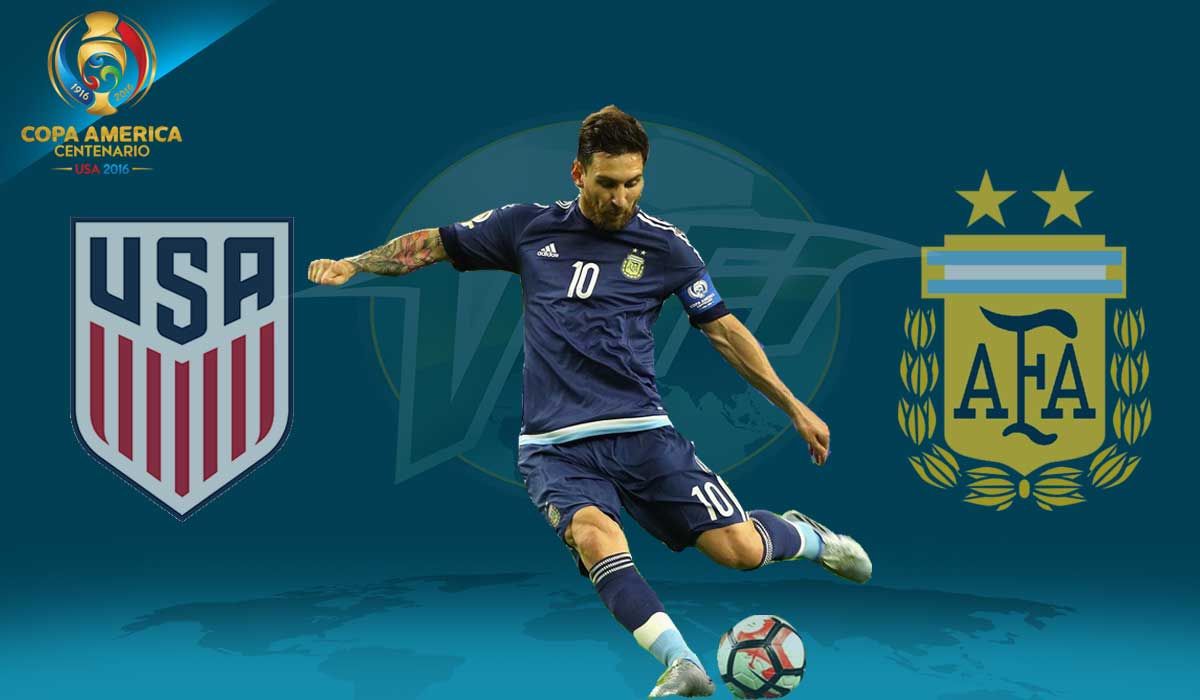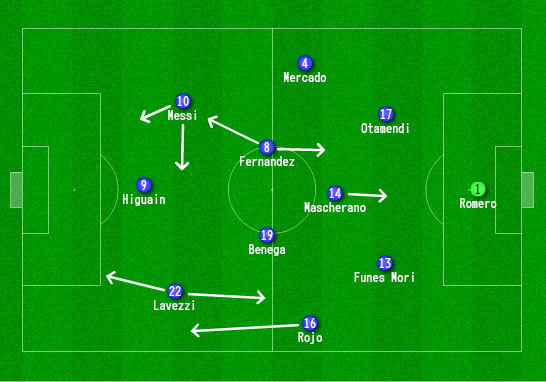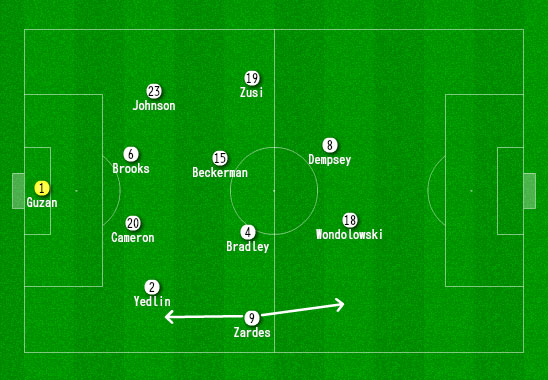It was supposed to be the biggest game in US soccer history, and maybe in some ways it will still be significant, but it might have been even more significant for this generation of Argentina players.
It’s hard to believe that Lionel Messi has no international honours of note, and while a team with an outstanding player will always gravitate towards them, to win they need to play as a unit, as proven by the failures of Portugal, or as they’re now known — Cristiano Ronaldo.
It’s often said that Messi would be accepted as the greatest player of all time if he had an international honour under his belt, which is a ridiculous sentiment, as this tweet from The Guardian’s Sid Lowe highlights:
If Higuain takes those two chances one year apart, is Messi the best player of all time?
— Sid Lowe (@sidlowe) July 4, 2015
Though he deserves the accolade regardless of trophies lifted in an Argentina shirt, it would be nice to have one against his name.
Messi has two Copa America runners-up medals. The first came back in 2007 when they were beaten by Dunga’s Brazil in the final, but a 20-year-old Messi wearing the number 18 walked away with an award for best young player. Then in 2015, Argentina lost on penalties to Jorge Sampaoli’s legendary Chile side. Messi scored his side’s only goal in the shootout before reportedly turning down the tournament’s best player award.
The USA, meanwhile, are all about the unit and nothing else. They should take heart from the tournament even if merely for the fact they were the first non-South American nation to host it, but they should also learn from the experience, and take action based on the lessons, but more on that later.
Messi’s Match
It didn’t take long for Messi to make an impact. A sumptuous chip over the defence from outside the area following a corner sucked Brad Guzan into a black hole between his goal and the attacker, rendering him useless as Ezequiel Lavezzi nodded in.
The U.S. defence pushed out raggedly but the winger still had to be alert to Messi’s pass and was perfectly positioned to take advantage of it.
The crowd had barely settled, and those who had were back on their feet soon enough thanks to this piece of magic from Argentina’s number ten.
Gerardo Martinez’s men looked organised — a rarity for La Albiceleste, who were today wearing their dark blue strip. They had a plan based around the strengths of each team member, which naturally allowed Messi’s talents to flourish as they do at Barcelona.
He loitered around Gonzalo Higuain, weighing up the U.S. defence while Lavezzi motored up and down the left wing, attacking Deandre Yedlin as well as supporting Marcos Rojo in defence.
Next came the small matter of Argentina’s all-time top goalscorer. Before this game this record belonged to the great Gabriel Batistuta, who managed 54 in 78 caps, but after the game it became yet another record belonging to Messi.
Lacing his boots up around 30 yards out from goal having just won a free kick, he cut a solitary figure at the type of set piece which usually has several players queued up as they look to fool the opposition. Positioned slightly to the left it would have been ideal for a right footer, too, but Messi stepped up with his left.
Not just any left, a silver Adidas left.
Most free kick takers choose to try to beat the wall, or fool the goalkeeper. Messi beat the wall, beat the goalkeeper, and found part of the top corner that most players don’t even know exists.
What an absolute beauty!
Lionel Messi became Argentina's top scorer with superb free-kickhttps://t.co/X6iCMzNvTj pic.twitter.com/bWLSzFAbHz
— BBC Sport (@BBCSport) June 22, 2016
As far as the rest of the team goes it was as convincing a display as you’ll see. Manager Martino was a surprise pick when he took over at Barcelona, but after that he was the obvious one to take over the national side.
There were elements of Barcelona in the team’s play, especially in the midfield where Mascherano acted as one of those defensive midfield sweepers we see in the modern game. The captain dropped to become a third centre back when needed — usually when starting an attack — before holding his position at the base of the midfield to protect the defence when the team pushed higher up the pitch.
Ahead of him were Ever Banega to the left, and Augusto Fernandez to the right, but the pair’s vertical position depended on the movement those around them. When Messi drifted inside from the right Fernandez would move forward into the space on the flank, but at times he would also drop deep to receive the ball from Mascherano.
Banega acted similarly on the left hand side, but due to Lavezzi’s tireless work rate down the left flank he was able to hold his position more and act as a playmaker from the centre of the park. If Mascherano was the fulcrum, then Banega was the start of the attacking lever.
Both full-backs offered width to the side, and both were willing to take up a starting position around the halfway line when their team had the ball. Rojo would regularly move into attacking positions using Banega and Mascherano as his insurance policy, while River Plate defender Gabriel Mercado was naturally more reserved on the right.
Their performance was rounded off by two goals from Higuain. One which he tucked in after seeing his initial shot saved by Guzan, whose parry fell into the striker’s path, and another he tapped in following an unselfish Messi pass.
That man again. Passing to his teammate when another with designs on being the best in the world would definitely have shot.
U.S.A! U.S.A.! U.S.Eh?
This Argentine unit limited the USA to a grand total of zero shots on goal, which was pleasing for Argentina but hugely disappointing for Jurgen Klinsmann’s men, and those who support them.
Depressing almost.
What was dubbed the biggest game in US Soccer history definitely turned into one of the biggest lessons.
The US players huddled together before kick-off, and as it turned out they were huddled together for much of the rest of the game.
What could have been an expansive 4-4-2 formation, especially down the right with wing forward Gyasi Zardes and attacking full back Deandre Yedlin, turned into a narrow mess.
Zardes spent much of his time at full back in an attempt to support Yedlin who drifted around the back covering for a non-existent midfield core.
The instructions may have been clear before the game, but the system looked restrictive. So much so that players forgot that they sometimes need to react to events around them and make decisions for themselves.
The team were shackled by the ceaseless Argentinian attacks, but also held back by their own system.
It was Zardes’ defensive header which led to the corner from which Argentina scored. The reaction to the short corner was one of confusion. Some players pushed out to the ball, others stayed, and Messi pounced on the weakness with unforgiving precision allowing Lavezzi to nod home.
When the U.S.A. did finally get the ball, they lacked ideas. They had just 33% of the possession in the game and as mentioned earlier they had no shots, not even a hopeful wayward punt into the stands.
That was one of the worst managed soccer games in our history – that I've ever witnessed at least
— Eric Wynalda (@EricWynalda) June 22, 2016
The disciplined defensive strategy had worked for the side in the past, most notably against Spain in the 2009 Confederations Cup semi-final, but in that game they also had a plan for what to do when they actually had the ball at their feet.
In this game the defensive strategy was broken, and the attacking outlets were non existent despite the presence of two forwards in Clint Dempsey and Chris Wondolowski.
Defeat to Argentina in the Copa America isn’t a disaster, and the tournament could even be said to be a success for the nation, but certain traits within the team have been a letdown.
The country has an array of players to draw upon. Players from different backgrounds, different football schools, and players with various qualities, but once they enter the national fold they appear restricted.
The free spirits end up on the periphery, while the functional but uninspiring prosper.
The US is a nation still searching for its soccer identity, and while a few onlookers may have rediscovered a passion for the game during this tournament played on their doorstep, the national team, thanks to its lack of style, still doesn’t inspire.
The culture at league and club level feels forced rather than being allowed to develop naturally through a national league structure.
At its worst it can come across as nothing more than a marketing exercise, and at its best it is brilliant but frustratingly restricted.
The US Open Cup provides a hint of what could be, but as fans who were excited by the Copa America begin to look for a club side closer to home, they might find that the opportunities for their local side are limited.
Nevertheless, on American shores and beyond, this tournament will go down in history.
For the hashtag-USMNT it was a history lesson, but for Lionel Messi and Argentina it could be a crucial chapter in the history of the greatest player of all time.




COMMENTS